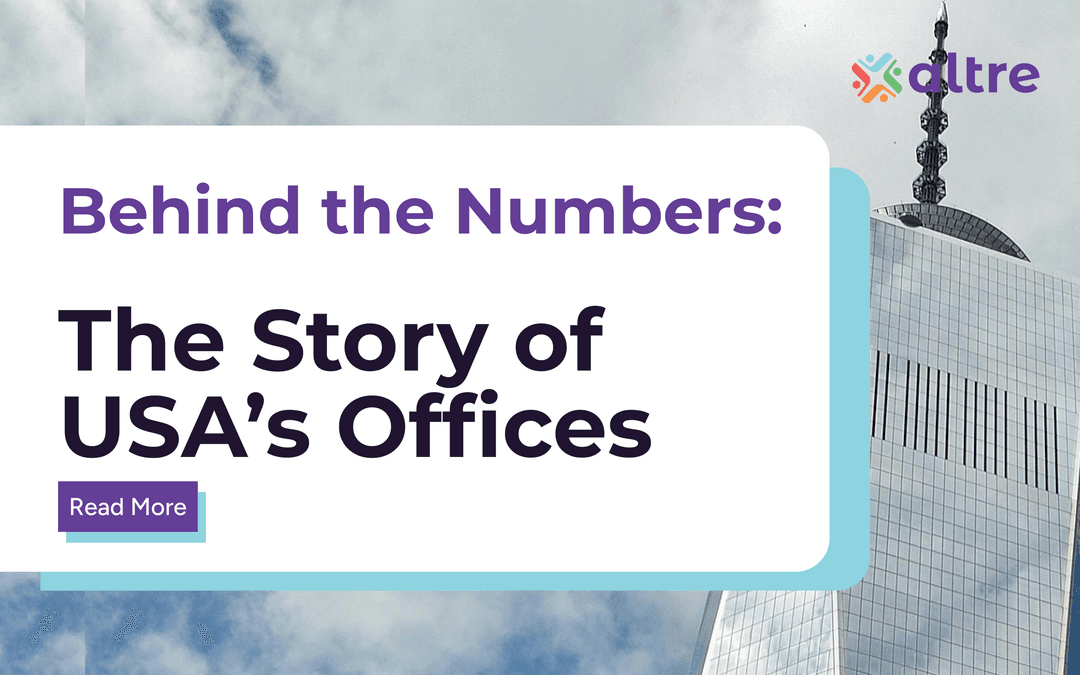
It's one of the most surprising puzzles in global real estate: India has nearly four times the population of the United States, yet America has built nearly four times the amount of office space. With 1.4 billion people compared to America's 330 million, one would expect India's office market to dominate. But the numbers tell a different story.
As of H1 2025, the United States holds approximately 4.8 billion sq ft of office stock, while India's top eight markets account for just over 1.2 billion sq ft. At first glance, the disparity looks overwhelming. But when you dig into absorption velocity, deal sizes, and purchasing power parity, the picture becomes far more nuanced.
India's office market may be smaller in raw terms, but in activity, efficiency, and growth momentum, it increasingly punches far above its weight.
The Numbers Game: Size vs Activity
On the surface, the United States dominates across every metric. In H1 2025, America recorded 138 million sq ft of leasing, against India's 37.3 million sq ft. Vacancy stood at 23.2 percent in the US, compared to 16.2 percent in India. As mentioned, stock levels also reinforce the contrast: 4.8 billion sq ft in the US versus 1.2 billion sq ft in India's top cities.
Numbers in Context
Absolute numbers don't tell the whole story. India's absorption velocity, the share of total stock leased in H1 2025, stood at 3.1 percent, marginally higher than the US at 2.9 percent. That means India leased more of its market on a proportional basis, even though its installed base is smaller.
The year-on-year comparison strengthens the case. India's absorption grew by 7.18 percent compared to H1 2024, signaling continued demand momentum. The United States, on the other hand, saw a contraction of 13.9 percent year-on-year, reflecting headwinds from hybrid work, capital constraints, and structural oversupply.
Vacancy rates reveal another dimension. America's vacancy of 23.2 percent reflects decades of overbuilding and a large stock of obsolete assets that still count toward official tallies. India's vacancy, at 16.2 percent, is healthier and concentrated in newer, flexible Grade A stock that global occupiers prefer.
As a result, India's occupied stock already stands at ~1.01 billion sq ft compared to the US's 3.69 billion sq ft. When leasing is normalized against occupied stock, both countries converge at around 3.7 percent leasing intensity in H1 2025, or roughly 7.4 percent annualized.
This means India is just as active as the US in relative terms. America only looks bigger because it accumulated more supply earlier.
Deal Size and Market Structure
The contrast becomes sharper when you examine average deal sizes. In India, the average lease signed in H1 2025 was about 42,000 sq ft, nearly double the US average of 25,214 sq ft.
This reflects structural differences. In the US, leasing activity is driven by a high degree of churn: renewals, subleases, and smaller adjustments to existing portfolios. In India, deals are led by Global Capability Centers (GCCs), tech firms, and BFSI majors making large-scale commitments and consolidations into campus-style hubs.
India is also building for the future. Developers are set to deliver approximately 250 million sq ft of new office supply, compared to just 40 million sq ft in the US. This contrast reflects a market still in growth mode versus one that has largely reached maturity.
In practical terms, India remains a build-to-suit market where supply is closely tied to occupier demand. The US, by contrast, is grappling with repositioning and conversions as much of its older stock struggles to attract tenants in a hybrid-first era.
Rental Values and the PPP Lens
At first glance, pricing favors the US. Prime office rents average $3.3 per sq ft per month (~$40 annually), while Grade A rents in India average $1.18 per sq ft per month (~$15 annually).
But once you adjust for purchasing power parity (PPP), the gap narrows sharply. In H1 2025, the US leased 138 million sq ft × ~$40 avg rent = ~$5.5 billion in annualized deal value. India leased 37.3 million sq ft × ~$15 avg rent = ~$560 million in actual terms, but $1.7–2.0 billion once PPP-adjusted.
That means India represented 30–35 percent of US deal value despite leasing only one-quarter of the physical area.
Yet this is a story of timing as much as scale. The US office market had a century-long head start, building out layer after layer of suburban and central business district inventory across multiple decades. India, by contrast, is in the middle of its high-growth phase, with its institutional office market only taking off in the 1990s and 2000s.
The Historical Advantage
The 4x inventory gap between American and Indian office markets represents one of the most fascinating case studies in comparative economic development and urban planning. This disparity stems from eight interconnected historical, policy, and structural factors that created fundamentally different trajectories for commercial real estate development in both nations.
1. The Century Head Start
The United States underwent its industrial revolution and rapid urbanization between 1870-1920, establishing the foundational infrastructure for modern commercial districts. Then in late 1930s, the entry of the United States into World War II caused vast changes in virtually every aspect of American life, including accelerated urbanization and commercial development patterns that would define the next century.
Major American cities like New York, Chicago, and Boston developed their central business districts during the late 19th and early 20th centuries, creating dense commercial cores that would later expand outward in concentric waves of development. This early foundation provided the template for office-intensive urban development that would be replicated across dozens of American metropolitan areas.
In contrast, India's modern office boom didn't begin until the economic liberalization policies of 1991, followed by the information technology revolution of the 1990s-2000s. This represents a 70-100 year developmental lag during which American cities were continuously building, expanding, and modernizing their office stock across multiple construction cycles and technological eras.
2. The Post-War Construction Explosion
The post-World War II economic boom created the most dramatic office construction surge in American history. Between 1947 and 1973, France went through a boom period (5% growth per year on average), and the United States experienced an even more pronounced expansion during this same period.
The post-war American economy saw one of the fastest growth in the world's history. After years of wartime rationing, American factories made the switch from war production to peacetime commercial construction. This transition unleashed unprecedented capital into real estate development, supported by favorable government policies, abundant credit, and a rapidly growing white-collar workforce.
The scale of this expansion was extraordinary. Tens of million of square feet were being added every decade, for decade on decade. Metropolitan office space grew from approximately 911 million square feet in 1979 to 2.7 billion square feet by 1999, a near tripling in just two decades. Suburban markets experienced also dramatic growth, with suburban office stock expanding over 1979-1999.
The suburban office park became an distinctly American innovation during this period, representing a low-density, car-dependent model of office development that would prove impossible to replicate in land-constrained markets like India. These developments typically featured large floor plates, extensive parking, and generous landscaping, all contributing to higher square footage per employee and lower overall development density.
3. American Workplace Norms
American workplace design philosophy has historically prioritized individual space allocation over density optimization. The cultural preference for private offices, larger cubicles, and generous common areas resulted in typical space allocations of 175-250 square feet per employee throughout much of the 20th century.
This spatial generosity reflected several uniquely American factors:
Cultural Individualism: American business culture emphasized hierarchy visualization through space allocation, with senior executives receiving progressively larger offices and better views, i.e, the vaunted American corner office. This created demand for buildings with higher floor-to-ceiling heights, larger window lines, and more flexible floor plates.
Regulatory Environment: Americans with Disabilities Act requirements, fire safety codes, and other regulations contributed to larger space footprints through mandated corridor widths, accessible bathrooms, and emergency egress requirements.
Technology Infrastructure: Before wireless networking and cloud computing, American offices required substantial space for server rooms, telecommunications equipment, and extensive cable management, all of which consumed significant square footage.
While modern American offices have densified toward 150-175 square feet per employee, this still substantially exceeds India's typical 80-120 square feet per seat in Grade-A buildings. Indian workplace design, developing during the digital era, could leverage cloud computing, wireless networking, and modern HVAC systems to achieve much higher density without sacrificing functionality.
The cumulative effect of these spatial differences, multiplied across millions of employees over decades of growth, created enormous disparities in total space requirements between the two markets.
4. Policy and Capital Frameworks
American tax policy has historically provided powerful incentives for real estate development, often encouraging construction ahead of actual demand. The most significant of these policies has been accelerated depreciation for commercial real estate.
Beyond tax policy, the development of Real Estate Investment Trusts (REITs) in the 1960s and their expansion in subsequent decades created deep, liquid capital markets for real estate investment. Institutional investors, like pension funds, insurance companies, and investment managers, channeled billions into commercial real estate development.
In contrast, India's office market development has been more recent and policy-driven. Special Economic Zones (SEZs), established in 2005, provided targeted incentives for export-oriented development. The Real Estate Regulation and Development Act (RERA) of 2016 introduced greater transparency and buyer protection. Indian REITs were only established in 2014 and didn't see significant market activity until 2019.
5. Market Breadth and Geographic Distribution
The United States tracks active commercial real estate markets across dozens of metropolitan statistical areas, each with distinct economic drivers, development patterns, and leasing activity. This geographic breadth creates aggregate transaction volumes that naturally exceed more concentrated markets.
Major American office markets include primary cities such as New York, Los Angeles, and Chicago, alongside substantial secondary markets like Nashville, Tampa, Austin, San Jose, and Kansas City. Each of these markets generates independent leasing activity, renewals, expansions, contractions, and new construction.
India's commercial real estate metrics focus on approximately 7-8 core cities: Mumbai, Delhi NCR, Bangalore, Chennai, Hyderabad, Pune, Kolkata, and Ahmedabad. While these cities are large and economically significant, the concentration means that national aggregate figures reflect fewer independent market dynamics.
6. Economic Scale and Sectoral Composition
The fundamental difference in economic scale between the United States ($28 trillion GDP) and India ($4 trillion GDP) creates proportionally different demand bases for office space. However, the sectoral composition differences are equally important.
The United States has maintained a service-sector economy representing approximately 80% of GDP, with finance, consulting, technology, research and development, and other office-intensive industries forming the economic backbone. This service sector matured over several decades, creating sustained demand for office space across multiple economic cycles.
India's service sector currently represents approximately 50% of GDP but is growing rapidly. The Indian IT services industry, in particular, has driven much of the country's office demand, growing from virtually nothing in 1990 to become a global force by 2010. However, this growth has been more concentrated in time and geography compared to America's more gradual, diversified service sector development.
7. Land Availability and Urban Development Patterns
Perhaps the most fundamental difference lies in land availability and utilization patterns. Only approximately 3% of United States landmass is urbanized (roughly 273,000 square kilometers out of 9.15 million square kilometers), compared to 8.7% in India (approximately 260,000 square kilometers out of 3.0 million square kilometers).
This land availability differential has profound implications for development patterns:
Suburban Sprawl: Abundant land enabled American cities to develop extensive suburban office markets with low-density, campus-style developments. These suburban office parks typically feature single-story or low-rise buildings with extensive parking and landscaping, creating high square footage per employee ratios.
Transportation Infrastructure: Abundant land also enabled extensive highway systems and road networks, making dispersed office locations economically viable for both employers and employees.
India's higher urban land utilization percentage reflects the opposite constraints. With limited available land in major metropolitan areas, Indian development has been forced toward higher density, vertical construction patterns. Indian office buildings typically feature:
Vertical Integration: Higher floor area ratios and building heights to maximize floor space per unit of land
Transit-Oriented Development: Concentration around existing transportation infrastructure due to land constraints
Mixed-Use Integration: Combining office, retail, and sometimes residential uses in single developments to optimize land utilization
Demand-Driven Development: Limited land availability makes speculative development more risky, encouraging demand-aligned construction
The Bottom Line
| Metric (H1-2025) | United States | India | Why the gap? |
| Total stock | ~4.8 bn sq ft | ~1.2 bn sq ft | Early build-out, suburbanization, higher sq ft/employee, and decades of capital-fueled supply. |
| Availability / Vacancy | ~23.2% Vacancy | ~16.2% Vacancy | U.S. counts direct + sublease; India tighter, younger stock. |
| Occupied stock (approx.) | ~3.69 bn | ~1.01 bn | Driven by the stock base more than demand intensity. |
| H1 leasing | 138 msf | 37.3 msf (Altre) | U.S. breadth + churn vs India's growth-led absorption. |
| H1 leasing as % of occupied | ~3.7% | ~ 3.7% | Normalized activity looks similar once base is adjusted. |
| Space per employee (typical) | ~150–175+ sf (historical 175–250) | ~80–120 sf | U.S. space norms are structurally higher. |
The raw comparison between India and the US might suggest a four-to-one gap in office market scale. But once you adjust for activity levels, vacancy profiles, deal sizes, and PPP, India's market tells a different story. It is smaller in footprint but every bit as active, more efficient, and far better positioned for growth.
For global occupiers and investors, the conclusion is straightforward: the US may still be the world's largest office market by legacy stock, but India is where the momentum lies. It is younger, denser, and increasingly the center of gravity for global office demand.
In commercial real estate, as in business, size isn't everything. What matters is efficiency, resilience, and growth trajectory, and on those fronts, India's office market is already closing the gap.


